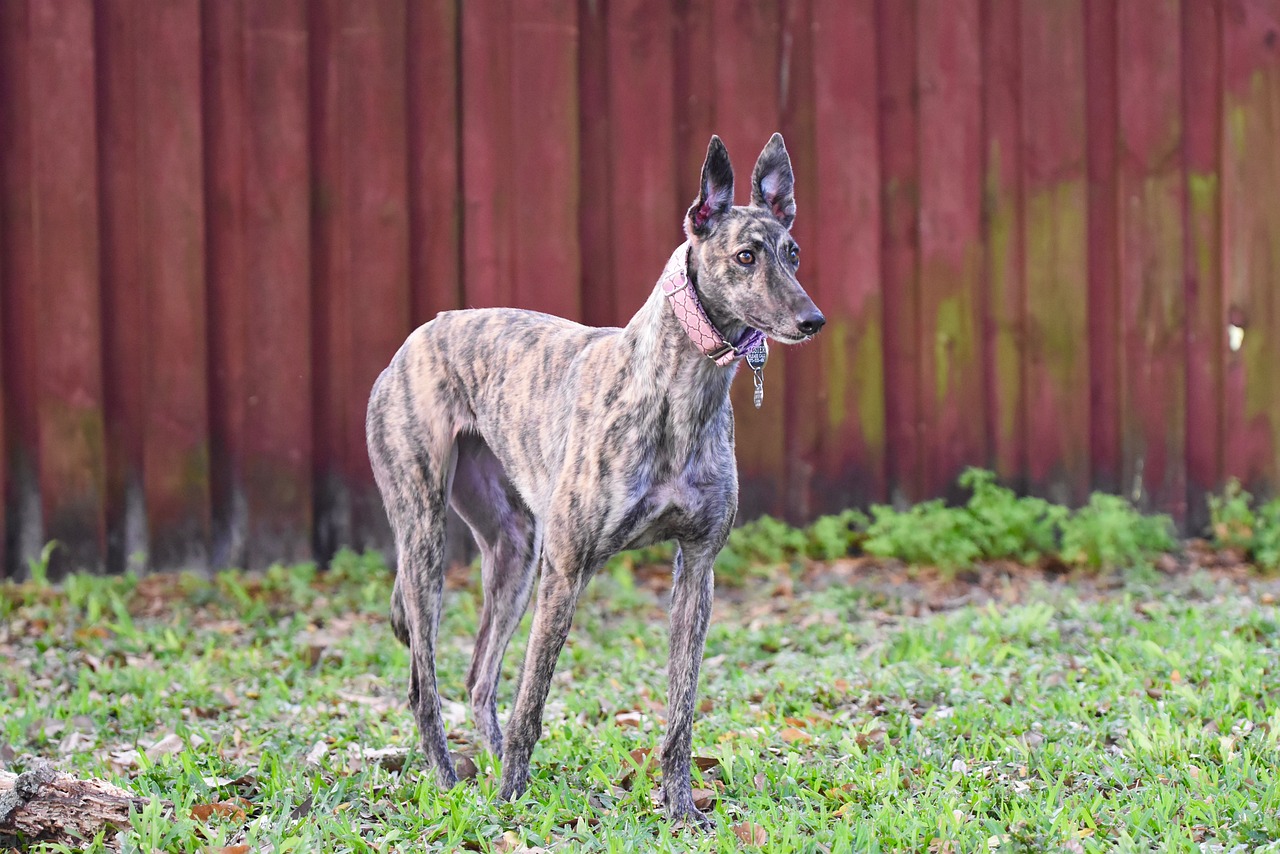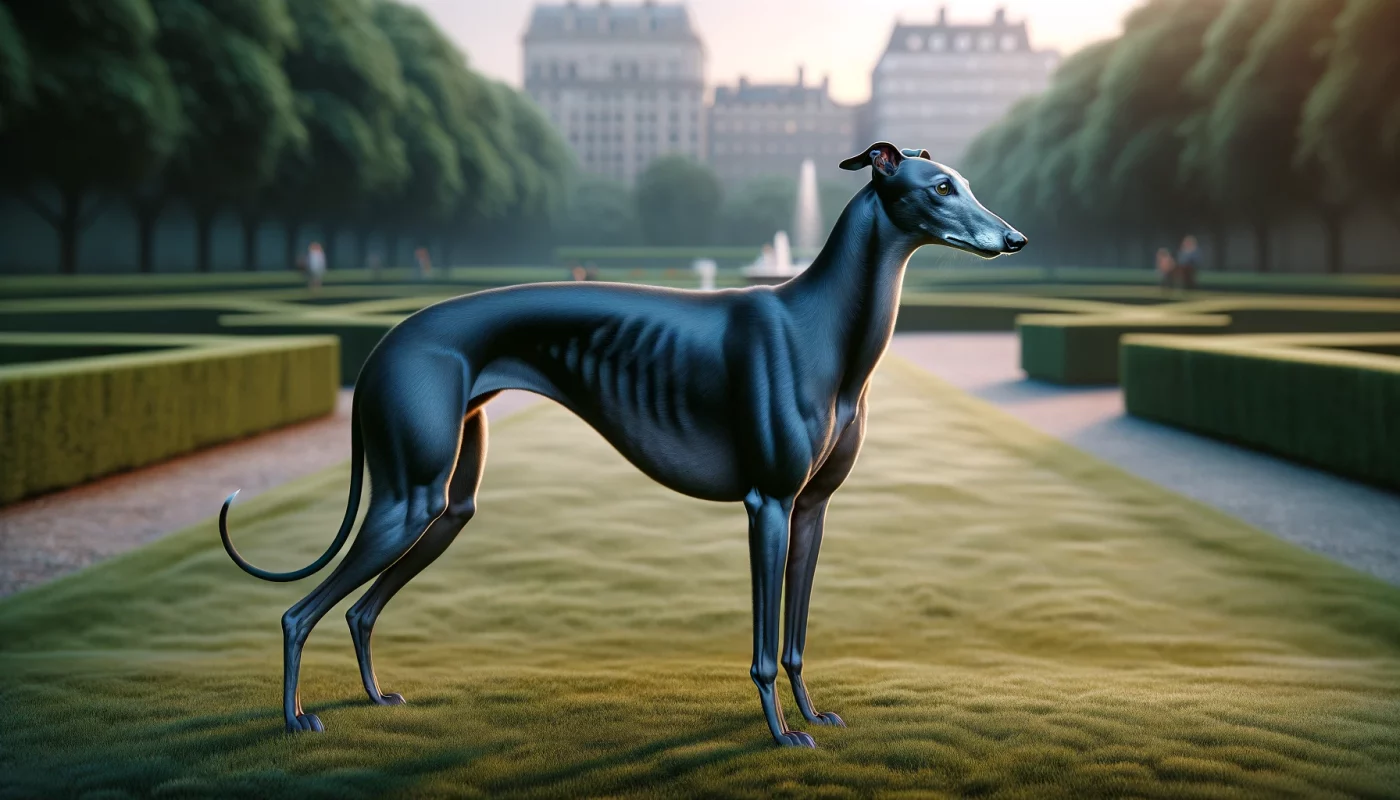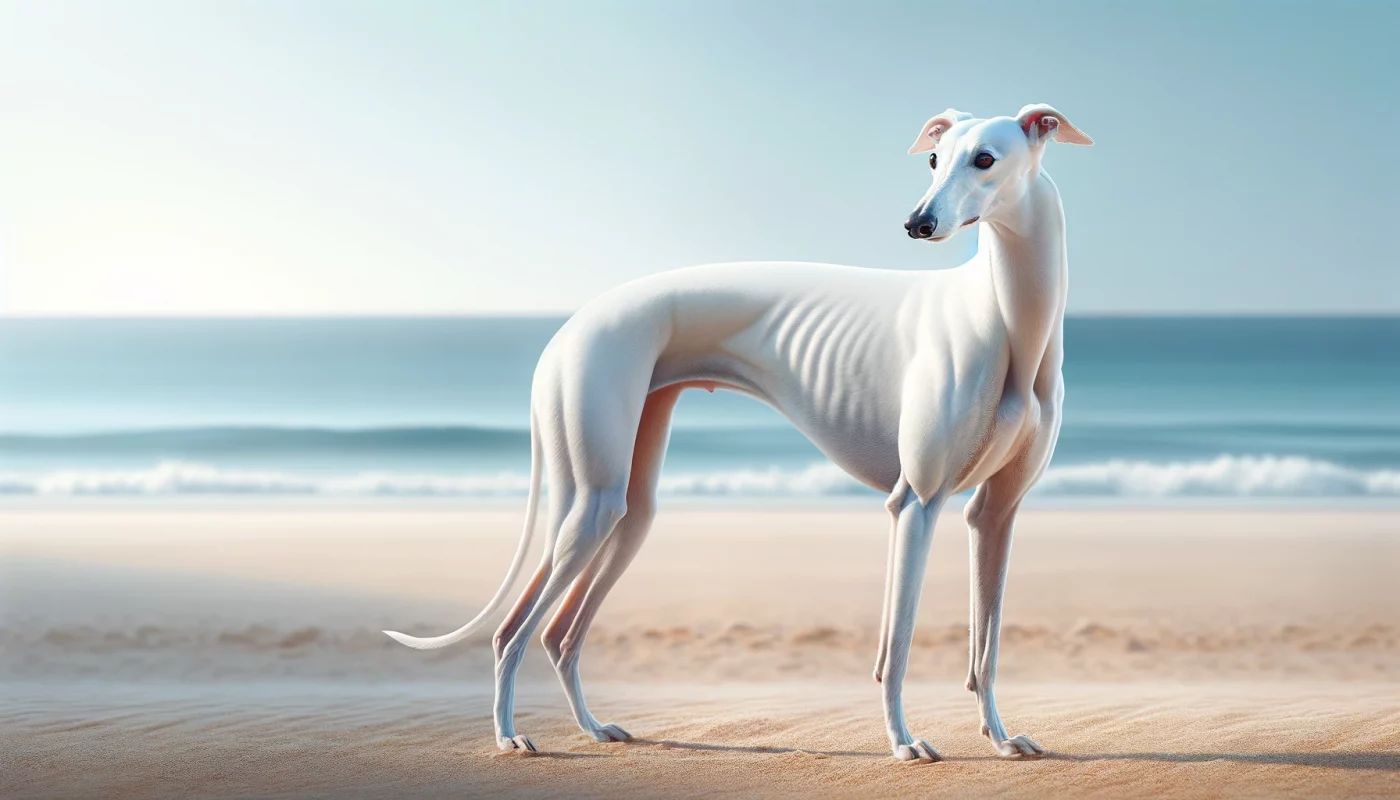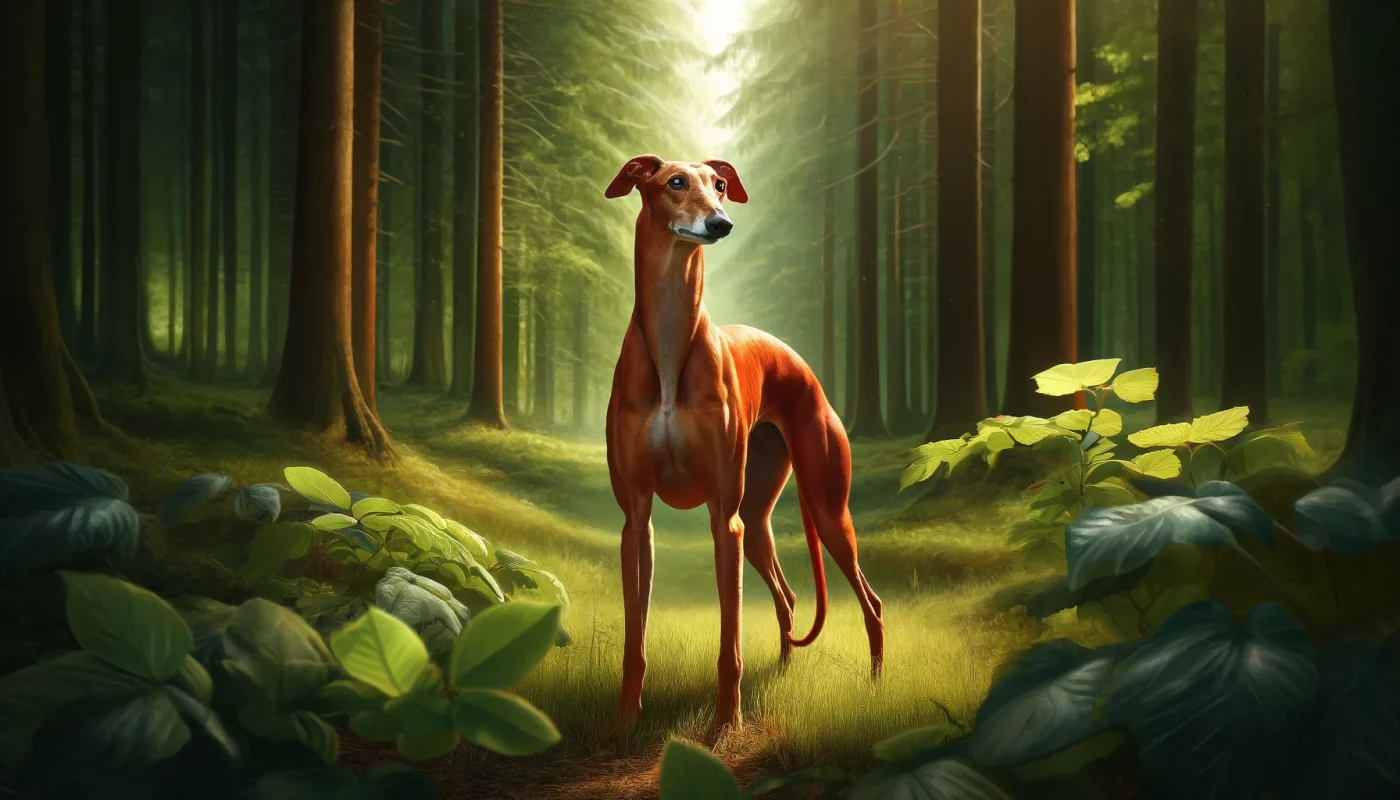The Greyhound, famed for its elegant, slender build and impressive speed, is a breed that boasts a surprising variety of coat colors. These dogs, often associated with racing and coursing, carry a genetic palette that allows for a range of beautiful and distinct colors. Each color not only adds to the aesthetic appeal of these graceful animals but also showcases the breed’s diverse genetic heritage. From classic solids to unique brindles, Greyhounds can sport almost any color imaginable. This article explores seven stunning coat color variations of Greyhounds, highlighting the unique traits and visual appeal of each.
1. Brindle

Brindle Greyhounds display a striking pattern of dark stripes on a lighter base, creating a tiger-stripe effect that is both eye-catching and majestic. This pattern can vary from sparse and subtle to dense and dramatic, often combining shades of black, brown, and tan. Brindle not only enhances the muscular contours of the Greyhound but also contributes to the breed’s camouflage abilities in their traditional hunting roles. Owners and breeders alike cherish this pattern for its complexity and the uniqueness it brings to each dog’s appearance.
2. Black
Black Greyhounds are sleek and sophisticated with their deep, uniform color that shines in the sunlight. This classic and elegant coat color highlights the breed’s smooth lines and graceful movements. Black is often preferred in racing circles for its perceived association with strength and agility. While common, the solid black coat never fails to make a dramatic statement, accentuating the dignified and noble air that Greyhounds are known for.
3. Blue

Blue Greyhounds have a diluted black coat that gives them a striking smoky gray appearance. This color is relatively rare and highly prized for its unique aesthetic. Blue Greyhounds often captivate onlookers with their almost mystical presence, their soft coat color contrasting beautifully with their bright, expressive eyes. This coat variation can range from a deep slate to a bar of lighter silver, making each blue Greyhound distinctly breathtaking.
4. White

White Greyhounds are stunning in their pure and pristine appearance. This coat color can range from pure white to white with patches of other colors. White Greyhounds stand out dramatically against any backdrop, their coats providing a sharp contrast to their lean, muscular physique. This color, while less common in a completely solid form, is often seen in combination with other colors in patterns like parti-color or piebald.
5. Fawn

Fawn Greyhounds possess a warm, sandy color that exudes a gentle and soft appearance. This color can vary from pale cream to a deeper golden hue and often features a darker shading along the back and ears. Fawn Greyhounds are particularly photogenic, with their light coats highlighting their swift, fluid movements and the gentle curves of their body structure.
6. Red

Red Greyhounds carry a rich, vibrant coat that can range from a coppery hue to a deep rust color. This striking coloration is eye-catching and provides a splash of brightness to the breed’s palette. Red Greyhounds often look like they are aflame when bathed in sunlight, their coats glowing warmly and enhancing their regal and athletic form.
7. Piebald

Piebald Greyhounds feature a pattern of irregular white and colored patches, creating a distinctive and often whimsical appearance. This pattern adds a playful element to the Greyhound’s sophisticated look, making each piebald individual uniquely attractive. The contrast between the white and colored patches highlights the lean, elongated features of the Greyhound, making them a favorite among those who appreciate distinctive markings.
Greyhounds are not only known for their speed and agility but also for their diverse range of beautiful coat colors. Each color variation adds a unique element to the breed’s appearance, enhancing their natural elegance and grace. Whether cloaked in the deep tones of black and red or the lighter shades of fawn and white, Greyhounds carry their colors with a natural pride that is as captivating as their swift movement. This array of colors not only adds visual interest but also celebrates the genetic diversity within this noble breed, making each Greyhound distinctively beautiful in its own right.
Frequently Asked Questions About Greyhound Colors
1. What are the most common coat colors in Greyhounds?
The most common coat colors in Greyhounds are fawn, black, red, and brindle. Fawn ranges from light sand to deep golden shades, often accentuated by a black mask or darker ears. Black Greyhounds possess a solid, deep black coat that showcases their sleek physique impressively. Red can vary from a soft, rust-like hue to a bright copper, adding a striking vibrancy. Brindle Greyhounds display a mix of colors that create tiger-stripe patterns, greatly varying in intensity from subtle to very pronounced. These colors are favored for their striking contrast and the way they highlight the Greyhound’s athletic build.
2. Are Greyhounds ever multi-colored?
Yes, Greyhounds can indeed be multi-colored. The most recognized multi-colored patterns in Greyhounds are brindle, piebald, and parti-color. Brindle patterns involve black stripes over a lighter base coat, which can be fawn, red, or even blue. Piebald Greyhounds have large, irregular patches of white and another color, often black or fawn. Parti-color refers to dogs with a predominantly white base with significant patches of another color. These multi-colored patterns add a unique character to each dog, making them quite popular among enthusiasts.
3. Can Greyhounds have blue coats?
Yes, Greyhounds can have blue coats. The blue coat color in Greyhounds is a dilute version of black, resulting from a genetic trait that affects the distribution of pigment in the coat. This gives the coat a striking smoky gray or slate color that is both rare and highly sought after. Blue Greyhounds often have a captivating appearance, with their muted coat color contrasting beautifully against their bright eyes.
4. What causes the brindle pattern in Greyhounds?
The brindle pattern in Greyhounds is caused by a genetic mechanism that overlays dark stripes on a lighter coat. This pattern results from the interaction of several genes, including one that causes the black stripes to be deposited along the coat in irregular intervals over a base color, which can be anything from light cream to gold or even red. Brindle is a dominant trait, meaning that only one parent needs to carry the gene for it to potentially appear in offspring, making it a relatively common pattern among Greyhounds.
5. Are white Greyhounds common?
White Greyhounds are less common than other colors like fawn or black. Pure white Greyhounds are rare; most white Greyhounds have some markings of another color. The white coloration can be linked to genetics that involve piebald or extreme white spotting, where pigmentation is absent in large areas of the coat. White Greyhounds, especially those that are predominantly white, often attract attention due to their stark, eye-catching appearance.
6. How does sunlight affect Greyhound coat colors?
Sunlight can cause the coat color of Greyhounds to fade, particularly in darker-colored or more vibrant dogs. Prolonged exposure to the sun can lighten the coat, making black Greyhounds appear brownish and red Greyhounds take on a bleached-out look. Owners are advised to consider sun exposure when spending time outdoors to maintain the richness of their Greyhound’s coat color.
7. Do Greyhound puppies change color as they grow?
Greyhound puppies can change color as they develop. Puppies born with darker coats, such as black or blue, may lighten as they mature. Similarly, brindle patterns can become more pronounced or slightly alter as the dog grows. This color evolution is a part of the breed’s development, and changes are usually complete by the time they reach adulthood.
8. Can coat color predict health issues in Greyhounds?
In Greyhounds, coat color itself is not typically linked to health issues. However, like many breeds with dilute colors, such as blue or fawn, Greyhounds may experience specific skin conditions associated with these pigments. For example, blue Greyhounds can sometimes suffer from a condition known as Color Dilution Alopecia, which causes thinning hair and sensitive skin. Potential owners need to be aware of these conditions when selecting a puppy.
9. What is the rarest color found in Greyhounds?
The rarest color in Greyhounds is true solid white. While white Greyhounds are often seen with patches of other colors, a completely solid white Greyhound is exceptionally uncommon and striking. This rarity is due to the genetic factors involved in producing a completely pigment-free coat, which is less likely to occur naturally.
10. Which Greyhound color is most preferred in dog shows?
In dog shows, the preference for Greyhound colors can vary, but generally, solid and richly pigmented colors such as deep blacks, vibrant reds, and clear fawns are favored. These colors tend to show off the Greyhound’s physical attributes effectively under show conditions. Brindle and blue are also popular for their uniqueness and visual appeal. Judges typically look for well-maintained coats that best exemplify the breed standards, regardless of color.
